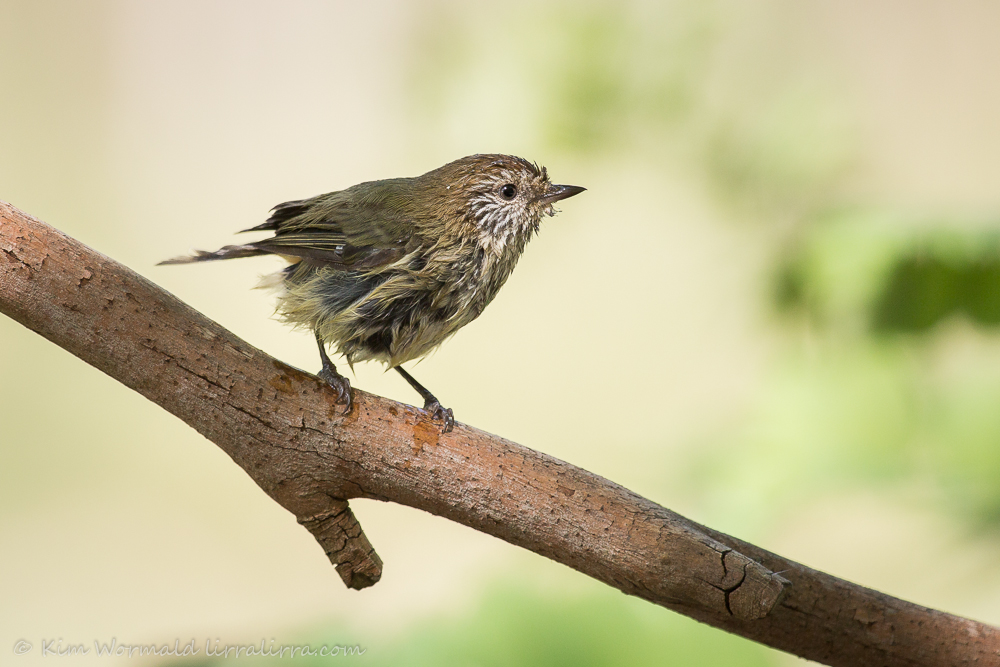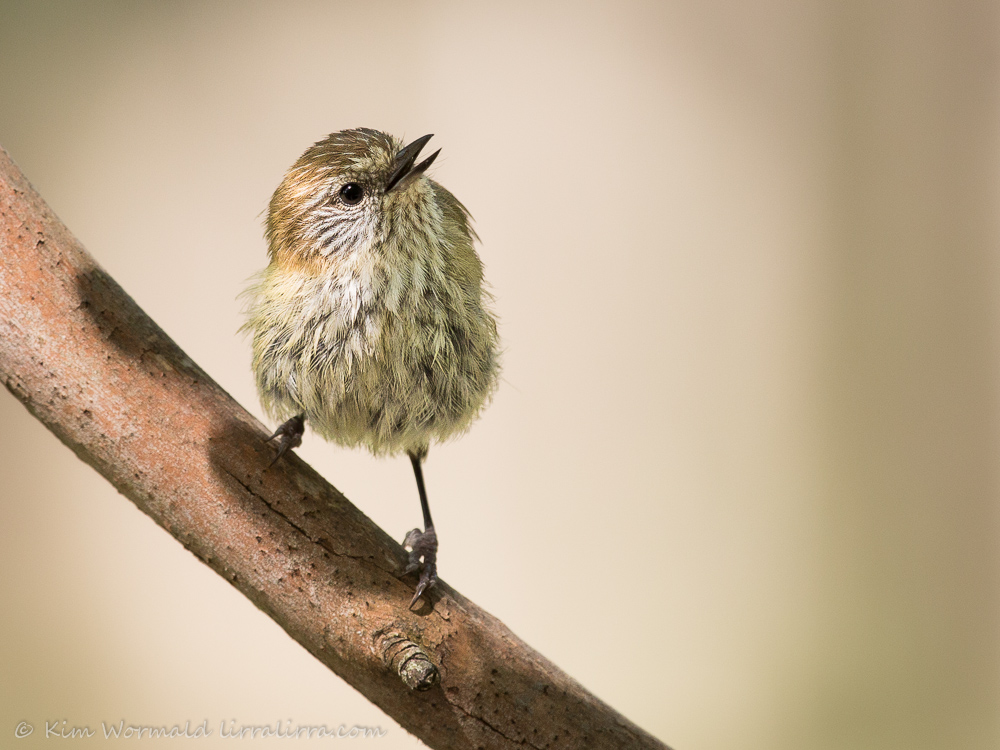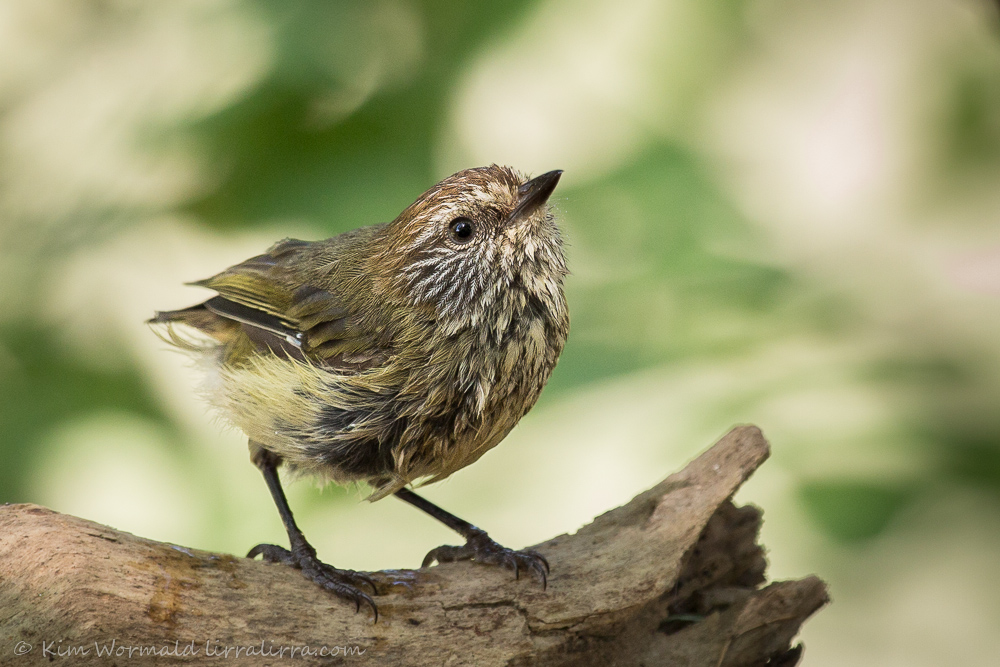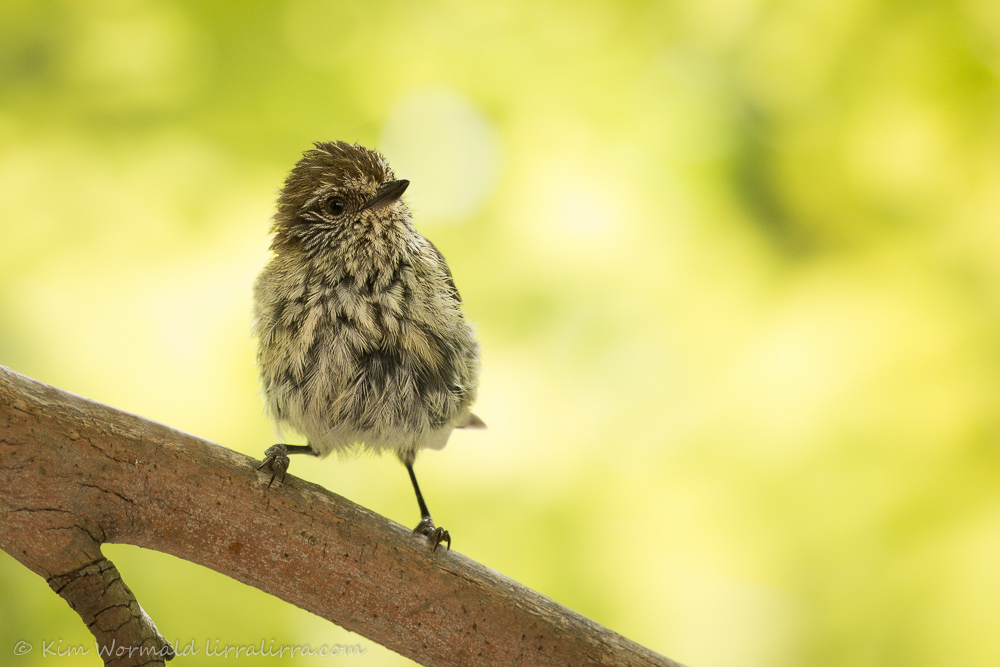My favourite birds to photograph are birds that are so small we could close our hand around them and hardly know they were there; birds that are tiny, fast and like to lurk in shadows.

Striated Thornbill (Acanthiza lineata)
Canon 5D Mk III, 100-400mm L IS USM, 1/800, f5.6, EV +1, ISO 400, focal length 400mm
This little thornbill ventured into the light to have a quick dip. This is one of the images in this post that are amongst the few I have taken with the 5D Mk III using aperture priority – it is difficult to use manual when birds are hopping in and out of shadows and the sun keeps hiding behind clouds.
I used to find thornbill species horribly difficult to distinguish from each other, which seems preposterous now that I see the differences so clearly. Striated Thornbills have white streaks on their russet coloured heads and bold streaks on their face/ear coverts, throat and breast. They have pale brown eyes, greenish backs and creamy underparts. They are 9-10cm in length and weigh a miniscule 7g.

Striated Thornbill (Acanthiza lineata)
Canon 5D Mk III, 100-400mm L IS USM, 1/400, f/5.6, EV +1, ISO 1600, focal length 400mm
This image was taken early one morning with the rising sun back-lighting the thornbill. It’s fun to be able to use such a high ISO and not have too much noise in the image.
 Striated Thornbill (Acanthiza lineata)
Striated Thornbill (Acanthiza lineata)
Canon 7D, 100-400mm L IS USM, 1/640, f/5.6, ISO 250, focal length 400mm
This is a 7D shot, taken when the sun was just about to set and everything was bathed in an incredibly warm glow. This was the session when I stupidly re-focused and missed a shot of the thornbill dangling upside down from a blossom – that shot became a ‘heart photo’, one that’s in my memory not on my memory card; I have albums full of heart photos!
Thornbills are agile feeders, flitting quickly amongst the leaves as they search for insects.
 Striated Thornbill (Acanthiza lineata)
Striated Thornbill (Acanthiza lineata)
Canon 5D Mk III, 100-400mm L IS USM, 1/1000, f5/6, EV +1 2/3, ISO 800, focal length 400mm
I shared the above image in an earlier post, Canon 5D Mark III, but felt I couldn’t do a post on Striated Thornbills that didn’t include this little singer. I have altered the crop from portrait to landscape, which I think looks better but maybe it doesn’t.
 Striated Thornbill (Acanthiza lineata)
Striated Thornbill (Acanthiza lineata)
Canon 5D Mk III, 100-400mm L IS USM, 1/640, f/5.6, EV 1 2/3, ISO 800, focal length 400mm
The thornbill’s greenish back shows in the above image which also clearly shows the striations. I find the facial striations the quickest way of identifying Striated Thornbills, often having been alerted to their presence by their weedy high-pitched “tiziz tiziz” call.
 Striated Thornbill (Acanthiza lineata)
Striated Thornbill (Acanthiza lineata)
Canon 5D Mk III, 100-400mm L IS USM, 1/1000, f/5.6, EV +1 2/3, ISO 800, focal length 400mm
Striated Thornbills are found between eastern South Australia and southern Queensland. Brown Thornbills and Yellow-rumped Thornbills are the only thornbills that live in Tasmania and on the mainland, but Tasmania is home to its very own Tasmanian Thornbill which would be lovely to see.
Happy birding, Kim
~ Thank you for your visit and comments.
~ If you’d like to receive a weekly email informing you that lirralirra has been updated please add your email address to the ‘subscribe’ box above right.

They are adorable birds. Awesome series of photos, Kim! Happy Birding!
Thank you Eileen, happy birding to you too!
Hi Kim, Great series of shots of this little guy – especially like that penultimate one where you can see those unusually shaped feathers on its cheek.(almost moss-like). Always enjoyable to see your photos each Friday.
They really are moss-like! Thanks Rick. I was trying to think of a way to describe them, they are key identifiers for me.
Beautiful photos Kim, it is a lovely “little’ bird.
Thank you Carole
Thank you. Not only do they move at least as fast as greased lightening, their erratic path makes lightening seem predictable.
Charmers one and all – and I have really enjoyed the opportunity to sit and gaze at them (for longer than a nano second).
You have a beautiful way with words EC, I always value your comments.
Love that second last photo in particular
Thanks Greg, I love knowing which images people like best, the subjective nature of photography is one of my favourite things about it
Such exquisite little birds! You have captured them skillfully and artfully, Kim. Great work!
Thank you Julie!